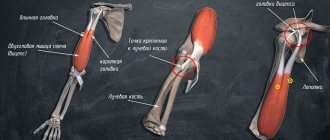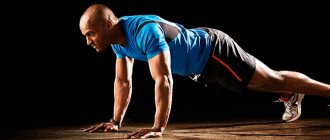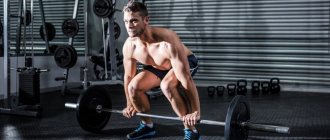Correct technique
- Grab the bar with an overhand grip and stand straight. Grip width is a debatable issue. But in general, the narrower the grip, the more difficult it is to keep your elbows straight to the sides, and therefore the greater the load goes on the front deltoids. A narrow grip also increases the range of motion. Optimal is slightly less than shoulder width.
- Straighten up - chest forward, shoulder blades retracted, lower back naturally arched. In the starting position, the arms are straight, the bar touches the hips.
- Inhale, while holding your breath, spread your elbows to the sides and pull them strictly vertically upward. Please note that the movement comes from the elbows, not the shoulders or forearms. The bar slides in a straight line up along the body.
- Where the elbows should be at the top point is also a controversial issue. It is enough to raise them to shoulder level - the deltoids will receive their share of the load from this. But if you want to properly work your trapezius, you need to raise your elbows higher, and the higher the better. This will be difficult to do with a wide grip.
- Exhale at the top point, and while holding your breath, smoothly lower the barbell down.
Standing barbell row to the chin on video:
Correct technique for performing the exercise
Next, let's talk about the correct technique for performing pull-ups with a snatch grip.
- Starting position: feet shoulder-width apart or slightly narrower, the bar of the barbell is located as close as possible to the shin, toes are slightly spread to the sides, the back is straight, we try to place our arms wide enough. How wide depends on the stretch of your pectoral and deltoid muscles. The wider the arms are, the smaller the amplitude and the more weight we can lift, but the load on the shoulder ligaments also increases.
- We begin to perform something like a classic deadlift with a barbell, sharply straightening the legs and lower back, maintaining a natural arch in the back.
- Let's move on to the demolition. When the barbell is just below the level of the athlete’s belt, and the knees have not yet fully bent, we begin to make a sharp upward movement with our shoulders, placing our elbows to the sides. Most of the load at this moment falls on the middle delta. If you're lifting heavy weights, you can do a tap—give the bar extra acceleration by hitting it with your upper thighs. Some athletes stand up a little on their toes when pulling, this gives the bar additional inertia - try it, maybe it will seriously increase your result. Here we do not do any squatting under the bar, as with a classic snatch. Our task is to “catch” the correct movement of the shoulders and elbows; we don’t need to load the quadriceps here.
- Watch the position of your elbows - they should be directed to the sides, do not try to press them closer to the body. If done correctly, the bar will rise to approximately mid-chest level. Without stopping, continue moving your shoulders up. At this point, the biceps and forearms are included in the work if you are not using wrist straps. At the same time, begin to rotate your hands so as to calmly fix the barbell at the top point on your straight arms.
There is another variation - first, grasp the barbell upward as much as possible and turn your hands, keeping your arms slightly bent, and then press it upward with the force of your deltoids, as if doing a military press. This option is more dangerous, and if you do not experience any discomfort in your shoulders and elbows when pulling with a snatch grip, stop with the first option.
Common mistakes
Performing the exercise in jerks . Explosive technique only makes sense if you are a weightlifter; in other cases, it is better to maintain a deliberately smooth pace of movement. However, occasionally it can be changed to explosive in order to “surprise” the muscles.
Shifting the elbows forward . They should go strictly to the sides, along the line of the body. However, moving them a little forward may not be a mistake if you want to pump up the front delts. Although there are more effective exercises for them.
Wrong choice of grip width . If it is too wide, it is difficult to raise the elbows higher; if it is too narrow, the load shifts towards the front delts.
The barbell is too heavy . Excessive weights will not allow you to raise your elbows high, which means the exercise will become less effective.
"Hovering" over the bar . He should move strictly along the straightened body, there is no need to hunch over it, or lower the chin towards it in order to reduce the amplitude of movement.
Relaxation of stabilizer muscles . As soon as you stop tensing your abs and lumbar muscles, your back will instantly round, and in this position there is a high risk of injury.
Dumbbell forward swings can be performed both to increase muscle volume and to burn fat.
About hanging leg raises is written in detail here: /silovye/press-i-kosye/s-press/podyom-nog-v-vise-na-perekladine.html.
Performing the exercise without holding your breath . If you exhale without reaching the barbell to your chin, your abs relax, and the load from the trapezius and deltoids transfers to the spine, which you absolutely do not need.
What muscles can you pump up?
The stretch is a multi-joint exercise that includes the deltoids and trapezius. The table will tell you which muscles work when pulling a barbell to the chin:
| Muscles | Location | Function in exercise |
| Middle bunch of deltas | Covers the top of the shoulder joint | Moves the arm up and away from the body |
| Trapezoid (trapezoid) | Rhomboid muscle in the center of the upper back | Raises the scapula and shoulder girdle; allows the scapula to rotate outward from the spine |
| Levator scapulae muscle | The back of the neck, covered with trapezoids on top | Elevates the shoulder joint and scapula |
| Anterior delta bundle | Covers the top and front of the shoulder joint | Flexes the shoulder - moves the upper arm up and forward |
| Supraspinatus muscle | Deep muscle of the upper back, covered by deltoids and trapezius; attaches to the humerus | Moves the shoulder to the side; actively participates at the very beginning of the broach |
| Top of the pectoralis major muscle | Covers the upper chest area | Helps raise the shoulder (upper arm - from shoulder to elbow) |
| Covers the front of the upper arm | Bends the arm at the elbow and rotates (supinates) the forearm | |
| Serratus anterior muscle | Covers the rib area (side of the chest) | Promotes scapula elevation and external rotation |
Barbell row to the chin (pull) - technique, tips
The barbell row to the chin (pulling) is an exercise for working the middle bundle of the deltoid muscles, and if you have no contraindications and do not experience discomfort when performing this exercise, then be sure to use it on shoulder training days.
Recently, the barbell row exercise (pull-up) has been subject to unfounded criticism, and many did not include it in their program for training the deltoid muscles. But this opinion is erroneous, since the barbell row to the chin is an effective exercise for the lateral deltoid muscles.
Difficulty level: recommended for both experienced athletes and beginners;
To perform the exercise you will need the following equipment:
- Straight barbell;
Exercise technique
- Grasp the barbell with an overhand grip, i.e. palm on top, grip width slightly narrower than shoulder width. The bar is located on the upper thigh with outstretched arms and slightly bent elbows. Your back should be straight. This is your starting position.
- Now, as you exhale, use your shoulders to lift the barbell through your sides, raising your elbows up. Keep the barbell close to your body as you lift up. Continue lifting the bar until it almost touches your chin. Tip: You need to pull with your elbows, many experienced trainers say, that is, your elbows should lead the movement, and the bar should always be higher than your forearms. Remember to keep your torso still and pause for a second at the top of the movement.
- Lower the barbell back down slowly to the starting position. Perform this part of the movement while inhaling.
- Repeat these steps for the recommended number of repetitions.
Tips for implementation:
- At the same time, pay attention to the technique of performing the exercise; when lifting the barbell to the top position, the load must fall directly on the shoulders, otherwise you are doing something wrong.
- If you are having difficulty performing the exercise, try using a wider grip or straps to make the exercise easier, or simply not lifting the bar very high.
- In addition, rowing the barbell to the chin with a wide grip shifts the load from the biceps and trapezius muscles to the middle deltoids.
Execution options:
- This exercise can also be performed using dumbbells, but should already be performed under the supervision of an instructor who is well-versed in proper technique for performing the movement.
Classic chest clean in video format
So, the exercise technique is very complex. To make it easier to understand the technique, we will separately analyze the stall, cast and hook.
Where to begin? The first thing you need to understand is that you need to strictly follow the technique, since the exercise can be very dangerous to health.
The starting position is as follows:
- The athlete stands at the barbell with his feet shoulder-width apart and the bar as close to his shin as possible.
- Pay attention to the center of gravity. It should be on the heels, the back remains straight throughout the entire approach of the exercise.
- You need to sit down and grab the bar with an overhand grip. The shoulders should be pulled back, the trapezius muscles should be kept tense, and the lower back should be slightly arched.
- The legs are bent at the knee joints at approximately 45 degrees. In this position, we begin lifting the barbell to the chest.
The task of this stage is to remove the sports equipment from the floor. The exercise differs from the deadlift in that the athlete will perform the movement with a wider amplitude. Therefore, the movement is carried out with great inertia.
Casting
As soon as the bar rises just above the knee joints, the athlete begins lifting the barbell to the chest. At this stage, he makes a pulling movement with his shoulders, moving them back a little. The movement is similar to pulling a barbell to your chin. Here you need to connect the elbow joints. In weightlifting, athletes stand on their toes when lifting the barbell. This nuance increases the inertial force. In my opinion, the feet should not leave the floor.
Podsed
As soon as the sports equipment reaches the level of the maximum point of movement, the athlete does a squat. At this point, the athlete should lower his elbows and do a squat. One significant point is that the depth of the squat depends on the working weight. The heavier the weight, the lower the squat is performed. If the movement is done correctly, the bar of the bar should fall to the top of the chest.
Correct technique and types of exercises
Pulling can be done with different grip widths. A narrow grip puts more stress on the trapezius and biceps, while a wide grip puts more stress on the middle and back of the deltoids.
When performing with a narrow grip, it is advisable to use a barbell with a curved bar. This will take the extra stress off your forearms and wrists, making the exercise more comfortable and safer, and allowing you to lift more weight.
Certified Practicing Trainer and Blog AuthorAsk a Question While performing the exercise, keep your back straight and your lower back slightly arched. Move your pelvis back. Feet shoulder width apart. The gaze is directed forward. In the bottom position, the arms are straight and the bar touches the front of the thighs. At the same time, try to keep your hands in line with your forearms throughout the entire trajectory, otherwise you may get injured. If you feel that your hands are bending too much in the upper position, reduce the height of the barbell.
Wide grip row
- The hands are located 1.5-2 times wider than the shoulders and hold the bar with a direct grip.
- As you exhale, pull the projectile up. The bar rises along the body to the middle of the chest, the elbows look to the sides and in the top position are at shoulder level.
- As you inhale, slowly lower the projectile down.
Close Grip Row
- Grasp the bar with an overhand grip. Between the palms is approximately 12-18 centimeters.
- As you exhale, pull the barbell up. Elbows move to the sides. In the top position, the elbows are higher than the shoulders, and the bar is at the level of the collarbones or slightly higher.
- Now lower the barbell to the starting position.
- Do all remaining reps in the same manner. Work smoothly, without jerking.
- The barbell can be replaced with a lower block or dumbbells. The technique remains the same, but the harm to the shoulders is reduced.
These videos will help you understand the exercise better.
Recommendations for athletes
At the end of the article, take into account a few recommendations that will help improve your training results:
- alternate options - you already know which grip of the barbell to the chin to use in this or that case;
- watch the position of your elbows - they should always be higher than your shoulders and the bar;
- hold for 1-2 seconds at the peak point, then smoothly lower the projectile;
- when working on strength with heavy weights, use straps; the exception is the presence of a powerful grip;
- number of repetitions: for strength – 4-6; for weight – 6-10; for relief – 10-20;
- barbell pull-ups are more suitable for men; For women, unless they are engaged in strength training, it is more advisable to train with dumbbells and exercise machines;
- for wrist pain, it is recommended to use elastic bandages or wristbands;
- the neck should follow the silhouette of the body; moving the bar away from the hips and body leads to increased load on the lower back and decreased load on the middle deltoids.











